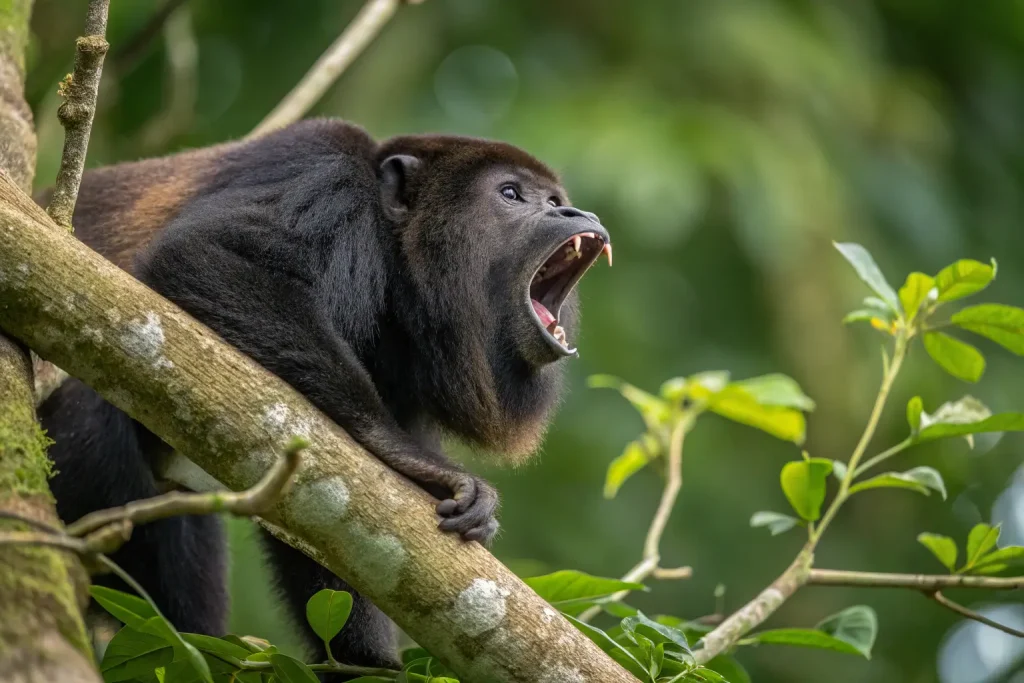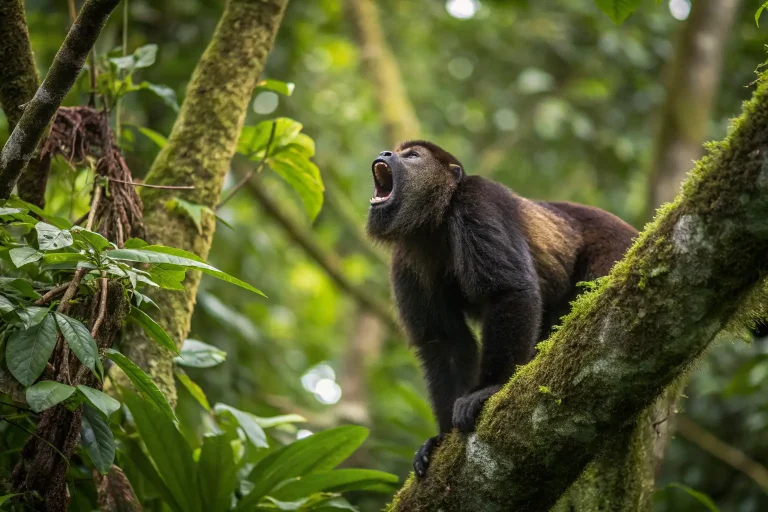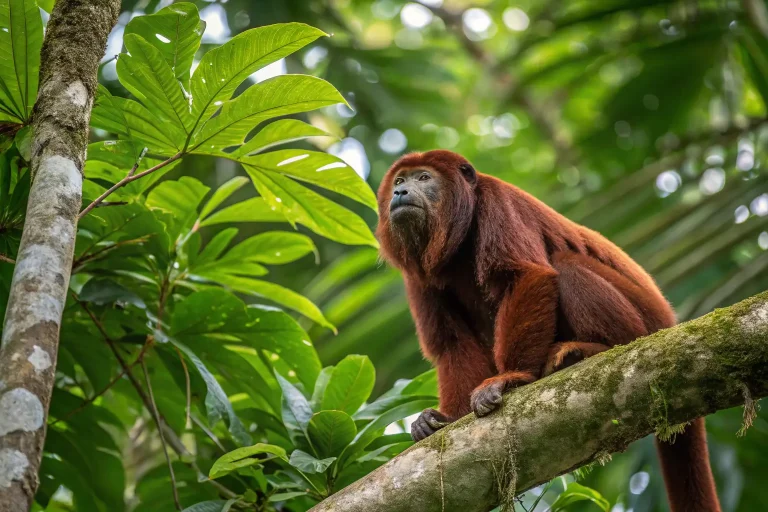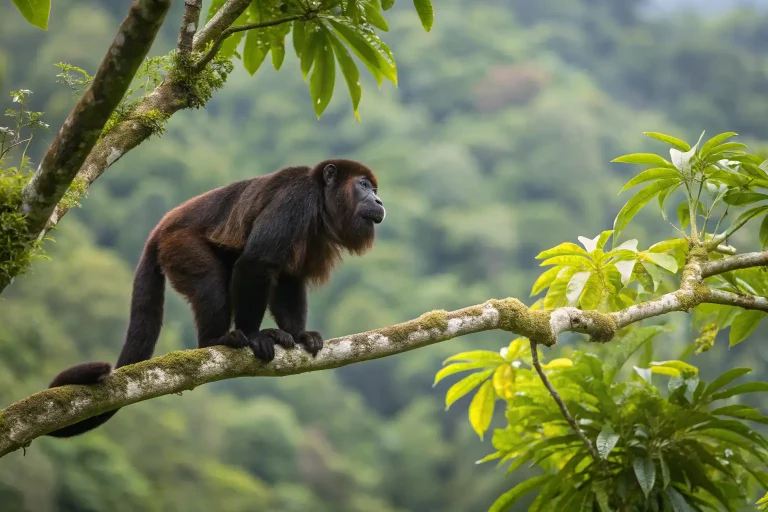Howler Monkey Sound: 7 Facts That Explain Their Incredible Calls
Introduction
Deep in the lush rainforests of Central and South America, a sound cuts through the dense foliage that can make even seasoned travelers freeze in their tracks. The howler monkey sound—an eerie, guttural roar—can travel for miles, often creating the impression of a far larger and more ferocious creature than these medium-sized primates actually are. These remarkable vocalizations are so powerful that howler monkeys have earned the distinction of being the loudest land animals on Earth, with calls that can be heard up to three miles away through dense jungle.
Understanding the howler monkey sound isn’t just about appreciating nature’s acoustic wonders; it provides fascinating insights into primate communication, social structures, and evolutionary adaptations. Whether you’re a wildlife enthusiast, a budding primatologist, or simply curious about these vocal champions of the animal kingdom, the science behind their calls reveals nature’s incredible ingenuity.
Did you know that a howler monkey’s hyoid bone (the bone supporting the tongue) is uniquely adapted to amplify their calls? It’s just one of many remarkable adaptations we’ll explore as we uncover the secrets behind those jungle-shaking howls.
Species Overview
Scientific Name: Howler monkeys belong to the genus Alouatta within the family Atelidae. There are currently recognized 15 species of howler monkeys, including the mantled howler (Alouatta palliata), the red howler (Alouatta seniculus), and the black howler (Alouatta caraya).
Physical Characteristics: Howler monkeys are among the largest of the New World monkeys, with males weighing between 15-22 pounds (7-10 kg) and females slightly smaller at 10-15 pounds (4.5-7 kg). Their most distinctive physical feature related to their famous sound is an enlarged hyoid bone in their throat, which functions essentially as a natural resonating chamber. This adaptation gives their voice incredible depth and volume.
They have prehensile tails that function as a “fifth limb,” allowing them to hang from branches while feeding. Their bodies are covered in thick fur that varies in color depending on the species—from golden and reddish-brown to black. Males and females of some species (like the black howler) exhibit sexual dichromatism, where males are black and females are blonde.
Subspecies: The howler monkey genus includes several distinct species with regional variations:
- The mantled howler (A. palliata) has three recognized subspecies, distributed from southern Mexico to Ecuador.
- The Mexican howler (A. pigra) is found in a limited range in Mexico, Belize, and Guatemala.
- The brown howler (A. guariba) has two subspecies, found primarily in the Atlantic forests of Brazil and Argentina.
Each species has evolved slightly different vocalizations, though all produce the characteristic howler monkey sound that gives them their name.
Habitat and Distribution
Natural Habitat: Howler monkeys are primarily arboreal, meaning they spend most of their lives in the treetops of various forest ecosystems. They prefer the high canopy of tropical rainforests, but different species have adapted to various forest types including:
- Primary and secondary rainforests
- Cloud forests
- Dry deciduous forests
- Flooded forests along river banks
- Gallery forests within savannah ecosystems
They rarely descend to the ground, finding everything they need—from food to sleeping sites—in the upper canopy layers.
Geographic Range: Howler monkeys are distributed throughout much of Central and South America. Their range extends from southern Mexico through Central America (including Guatemala, Honduras, Nicaragua, Costa Rica, and Panama) and into South America (Colombia, Venezuela, Bolivia, Brazil, Peru, Argentina, and Paraguay). Different species occupy different parts of this broad range, often with minimal overlap.
Adaptations: Beyond their vocal apparatus, howler monkeys have adapted to their arboreal lifestyle in several ways that complement their famous sound-making abilities:
- Their prehensile tail allows them to hang securely while feeding, freeing their hands.
- A specialized digestive system helps them extract nutrients from a leaf-heavy diet—an adaptation that allows them to survive in areas where fruit may be seasonally scarce.
- Their relatively slow metabolism conserves energy, enabling them to subsist on a lower-calorie diet of leaves when necessary.
- Group living provides protection and helps them defend resource-rich territories using their powerful howler monkey sound as a territorial advertisement.
Diet and Feeding Habits
What They Eat: Howler monkeys are primarily folivores (leaf-eaters), though their diet is more varied than this classification suggests:
- Leaves (primarily young, tender leaves that are easier to digest)
- Fruits (when seasonally available)
- Flowers and flower buds
- Nuts
- Occasionally small amounts of bark and stems
This flexible diet allows howler monkeys to survive in environments where other primates might struggle, as leaves are almost always available even when fruit is scarce.
Foraging Behavior: Unlike many primates that travel long distances daily in search of food, howler monkeys conserve energy with a relatively sedentary lifestyle. They typically move slowly and deliberately through their home range, which can be as small as 10 acres for some groups. Their feeding pattern includes:
- Peak feeding periods in early morning and late afternoon
- Resting during the hot midday hours
- Selectively choosing younger leaves with higher protein and lower toxin content
- Using their howler monkey sound to mark feeding territories and avoid competition with neighboring groups
Dietary Needs: Their leaf-heavy diet presents specific nutritional challenges that have shaped howler monkey physiology:
- Their enlarged hindgut functions as a fermentation chamber where symbiotic bacteria break down cellulose from leaves.
- They sometimes eat clay from specific riverbank sites, which may help neutralize toxins found in some leaves.
- They require less food than similarly sized primates because of their energy-conserving lifestyle.
- Their slower metabolism—an adaptation to a lower-calorie diet—is one reason they move less and howl more than many primates.
Behavior and Social Structure
Social Behavior: Howler monkeys live in cohesive social groups typically containing:
- 5-20 individuals (though group size varies by species)
- A mix of adult males, females, and their offspring
- Either one dominant male (in single-male groups) or several males (in multi-male groups)
The group’s social dynamic is relatively peaceful compared to many primates, with less intense competition among males than seen in some monkey species. This social harmony may be partially attributed to their energy-conserving lifestyle and the fact that they defend their territory primarily through the howler monkey sound rather than physical confrontation.
Communication: While their famous howling gets the most attention, howler monkeys use a variety of communication methods:
Vocal Communication: Beyond the iconic howler monkey sound (which we’ll explore in detail in the “Interesting Facts” section), they use:
- Soft grunts and barks for within-group communication
- Warning calls when predators are spotted
- Different vocalizations between males and females
Visual Communication:
- Facial expressions
- Body postures
- Tail positioning
Tactile Communication:
- Grooming to reinforce social bonds
- Play behavior, especially among juveniles
- Physical contact during rest periods
Mating and Reproduction: Howler monkeys have several interesting reproductive characteristics:
- Females typically give birth to a single infant after a gestation period of approximately 6 months.
- Infants are carried on the mother’s belly for the first month, then gradually begin riding on her back.
- Weaning occurs at 12-15 months of age.
- Males reach sexual maturity at about 5 years, females slightly earlier at 3-4 years.
- Their lifespan in the wild is typically 15-20 years.
In some species, like the red howler, females leave their natal group when reaching maturity, while in others, males are the ones to disperse.
Conservation Status
Endangerment Level: The conservation status varies significantly among howler monkey species:
- The Mexican black howler (A. pigra) and the brown howler (A. guariba) are listed as Endangered on the IUCN Red List.
- The Guatemalan black howler (A. pigra) is listed as Vulnerable.
- The red-handed howler (A. belzebul) is Near Threatened.
- Several others, including the mantled howler (A. palliata), are listed as Least Concern, though their populations are still declining.
Threats: Several major threats are impacting howler monkey populations:
Habitat Loss: Deforestation for agriculture, logging, and urban expansion has destroyed significant portions of their habitat.
Fragmentation: Remaining forest patches are often too small and isolated to support viable populations, limiting genetic diversity.
Hunting: In some regions, howler monkeys are hunted for food or captured for the illegal pet trade.
Disease: Yellow fever outbreaks have decimated some populations, particularly of brown howlers in Brazil.
Climate Change: Shifting climate patterns affect food availability and may increase disease vulnerability.
Conservation Efforts: Several initiatives are working to protect howler monkeys:
- Protected area establishment and expansion in key habitat regions.
- Reforestation programs to reconnect fragmented habitats.
- Captive breeding programs for the most endangered species.
- Research projects to better understand howler monkey ecology and behavior, including how their iconic howler monkey sound functions in their social dynamics.
- Educational programs for local communities to reduce hunting and habitat destruction.
Interesting Facts: The Science Behind the Howler Monkey Sound

1. Anatomical Adaptations Create Their Powerful Calls
The most remarkable feature behind the howler monkey sound is their hyoid bone—a specialized U-shaped bone in the throat that’s dramatically enlarged compared to other primates, including humans. This bone forms a resonating chamber that amplifies their vocalizations to an astonishing degree. The male howler’s hyoid bone can be as large as a chicken egg, taking up significant space in their throat and giving their calls incredible depth and resonance.
This anatomical specialization represents one of the most extreme vocal adaptations in the primate world. Interestingly, there’s a tradeoff: species with larger hyoid bones and louder calls tend to have smaller testes, suggesting an evolutionary compromise between vocal display and sperm competition.
2. Their Calls Can Reach 140 Decibels
The howler monkey sound can reach an incredible 140 decibels—as loud as a jet engine at close range and well above the human pain threshold of around 120 decibels. This makes them the loudest land animals on the planet, with calls that can be heard up to three miles away through dense jungle.
For context, that’s louder than:
- A rock concert (120 dB)
- A chainsaw (110 dB)
- A motorcycle (95 dB)
This volume is particularly impressive considering the howler monkey’s relatively modest size compared to other loud animals like elephants or lions.
3. Dawn Chorus Serves Multiple Social Functions
One of the most iconic aspects of the howler monkey sound is their “dawn chorus”—coordinated howling sessions that typically begin around dawn and can last for up to an hour. These acoustic displays serve several crucial purposes:
- Territorial advertisement: Declaring ownership of a specific forest area to keep competing groups at bay
- Resource protection: Warning others away from valuable feeding trees
- Group cohesion: Strengthening bonds within the group through cooperative calling
- Mate attraction: Showcasing genetic fitness through vocal prowess
- Morning coordination: Synchronizing the group’s activities for the day
Researchers believe these dawn choruses help groups maintain spacing in the forest without direct confrontation, conserving valuable energy.
4. Males and Females Produce Different Calls
The classic deep, resonant howler monkey sound is primarily produced by adult males, whose larger hyoid bones create lower-frequency calls. Females also participate in group howling sessions but produce higher-pitched calls that serve as counterpoints to the males’ bass notes.
This sexual dimorphism in calls allows:
- Listeners to identify the composition of distant groups
- Potential dispersing monkeys to locate groups with favorable male-to-female ratios
- Possible mate selection based on vocal characteristics
In some species, like the mantled howler, females will actually initiate group calling sessions that the males then join, suggesting complex social coordination around their vocalizations.
5. Weather and Environmental Conditions Trigger Howling
The howler monkey sound isn’t produced randomly—specific environmental triggers often prompt howling sessions:
- Weather changes: Groups often howl before or after rainstorms
- Temperature shifts: Dawn temperature changes appear to be a significant trigger
- Acoustic conditions: They may preferentially howl when atmospheric conditions favor sound propagation
- Human disturbance: Unfamiliar sounds or human activity can trigger defensive howling
These patterns suggest howler monkeys are highly attuned to their acoustic environment and may use specific conditions to maximize the effectiveness of their calls.
6. Howling Helps Avoid Physical Confrontation
The impressive howler monkey sound serves as a form of “acoustic territoriality” that helps groups maintain spacing without direct physical confrontation. This energy-efficient strategy is particularly important given their leaf-based diet, which provides relatively limited calories.
When groups do encounter each other at territory boundaries, they engage in “howling battles” that can last for hours, with each group trying to out-vocalize the other. The group that howls more impressively typically “wins,” with the other group retreating—all without physical fighting that could lead to injury or death.
7. Brain Size Has Been Sacrificed for Vocal Apparatus
Perhaps the most fascinating evolutionary tradeoff behind the howler monkey sound is that their specialized vocal anatomy appears to have come at the expense of brain size. Compared to other similar-sized primates, howler monkeys have significantly smaller brains.
This evolutionary compromise suggests that the selective pressure for loud, impressive vocalizations was so strong that it outweighed the benefits of larger brain capacity. It’s a remarkable example of how evolution sometimes favors specialized adaptations (in this case, the howler monkey sound) over general cognitive capabilities.
Role in the Ecosystem
Ecological Importance: Howler monkeys play several crucial roles in their forest ecosystems:
Seed Dispersal: Despite being primarily leaf-eaters, they consume enough fruit to serve as important seed dispersers. Their relatively slow digestion allows seeds to be transported far from parent trees, increasing plant genetic diversity.
Forest Regeneration: Their selective feeding on leaves and fruits influences forest composition and contributes to natural regeneration processes.
Indicator Species: Due to their sensitivity to habitat fragmentation and environmental changes, howler monkey populations serve as indicators of overall forest health.
Acoustic Ecosystem: Their howler monkey sound is part of the forest’s acoustic ecology, potentially influencing the behavior of other species and contributing to the overall soundscape that characterizes these ecosystems.
Impact of Decline: The decline or local extinction of howler monkeys can have several cascading effects:
- Reduced seed dispersal for certain plant species, potentially altering forest composition over time
- Changes in vegetation structure due to altered browsing patterns
- Loss of prey for predators such as harpy eagles and jaguars
- Disruption of the complex acoustic environment that characterizes healthy rainforests
- Potential increases in certain insects and small vertebrates that might otherwise be influenced by howler monkey presence
Conclusion
The iconic howler monkey sound represents one of nature’s most remarkable adaptations—a specialized communication system that has shaped everything from these primates’ social structures to their very anatomy. Their enlarged hyoid bone, capable of producing calls up to 140 decibels, exemplifies how evolutionary pressures can drive extreme specialization.
These vocalizations aren’t merely impressive noise—they’re sophisticated tools that serve multiple functions, from territorial defense to group cohesion, all while minimizing the need for energy-expensive physical confrontations. The fact that evolution has favored vocal prowess even at the expense of brain size highlights just how crucial these calls are to howler monkey survival.
As rainforests continue to face threats from deforestation and climate change, preserving howler monkey habitat isn’t just about saving a single species—it’s about maintaining the complex ecological relationships they’ve developed over millennia. By supporting rainforest conservation efforts, sustainable tourism that values these remarkable primates, and research into their behavior and ecology, we can help ensure that the haunting howler monkey sound continues to reverberate through Central and South American forests for generations to come.
Frequently Asked Questions
Why do howler monkeys howl?
Howler monkeys howl primarily to defend their territory and resources without physical confrontation. Their calls advertise group presence, deter competing groups, strengthen social bonds within the group, and can attract potential mates. They typically howl at dawn, during weather changes, or when they encounter other groups or potential threats.
How loud is a howler monkey’s call?
A howler monkey’s call can reach up to 140 decibels—as loud as a jet engine at close range and well above the human pain threshold. This makes them the loudest land animals on Earth, with calls that can travel up to three miles through dense jungle.
Can howler monkeys be kept as pets?
No, howler monkeys should never be kept as pets. They’re wild animals with specialized dietary needs, complex social requirements, and behavioral patterns that cannot be properly accommodated in captivity. Additionally, the international trade in howler monkeys is regulated, and in many countries, it’s illegal to keep them as pets.
How do howler monkeys produce their loud calls?
Howler monkeys produce their distinctive calls through a specialized U-shaped hyoid bone in their throat that functions as a resonating chamber. This bone is dramatically enlarged compared to other primates (about the size of a chicken egg in males), creating space for their vocal folds to vibrate and amplifying their calls to extraordinary volumes.
Are howler monkeys dangerous to humans?
Howler monkeys are not typically dangerous to humans. They’re generally shy animals that prefer to avoid human contact. Unlike some primates, they’re not known for aggressive behavior toward humans. Their impressive howling might sound intimidating, but it’s primarily directed at other howler monkey groups, not at people.
What’s the difference between howler monkeys and spider monkeys?
While both are New World monkeys, howler monkeys are known for their loud vocalizations and specialized throat anatomy. They’re more heavily built and move more slowly than spider monkeys. Spider monkeys have longer, more slender limbs, smaller heads, and are more acrobatic. Spider monkeys don’t have the enlarged hyoid bone or loud calls characteristic of howler monkeys.
Are howler monkeys endangered?
Some species of howler monkeys are endangered, including the Mexican black howler and the brown howler, which are listed as Endangered on the IUCN Red List. Others are Vulnerable or Near Threatened. The primary threats they face are habitat loss due to deforestation, hunting, and disease outbreaks like yellow fever.





